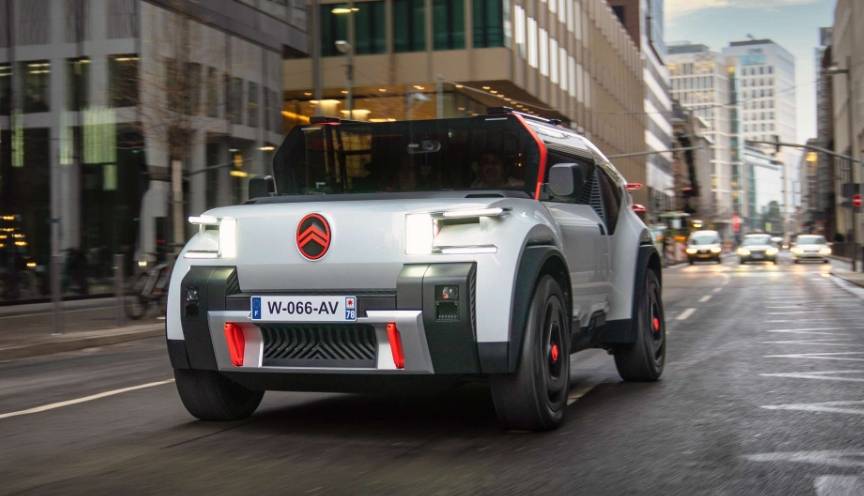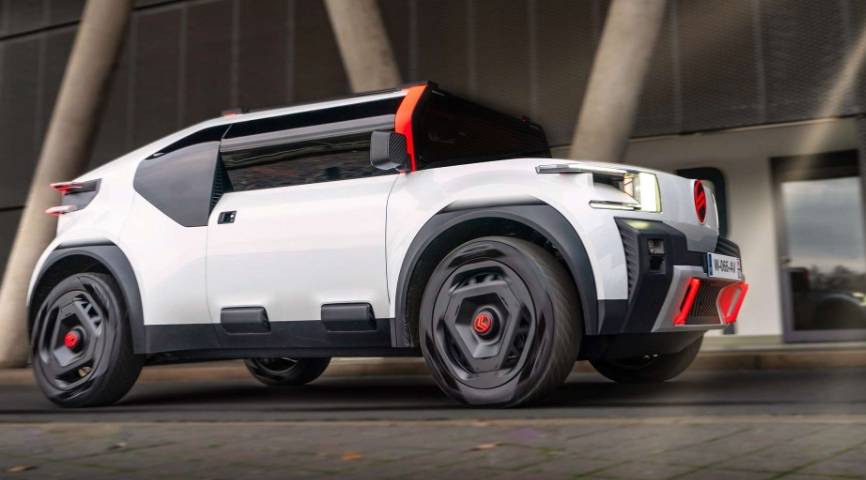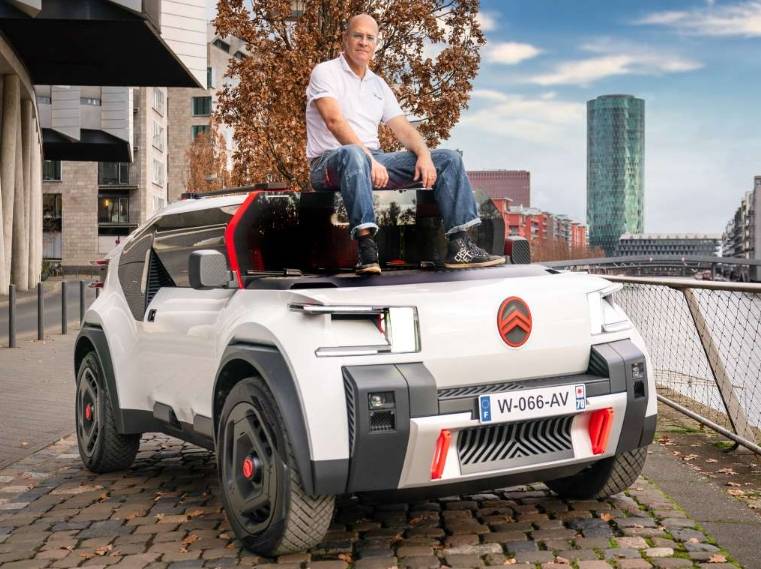With the Oli study, Citroën has knocked out a minimalist that will not be built like this, but brings with it many innovative approaches to sustainability.
For a prototype, it drives astonishingly grown up – Citroën, together with BASF, has installed many sustainable ideas in the Oli – and, in addition to the new logo, at the same time gave a few hints about future design details of the brand. According to press spokesman Christopher Rux, a surprising number of them will be found on future series vehicles from 2023.
The idea of the wild-looking study, which looks almost like an off-road vehicle from the US Army in terms of proportions – but which is fighting for the reduction of the CO2 footprint here: Sustainability should create its own circular economy. The vehicle should remain simple and affordable and be able to be reinvented or prepared for multiple owners. To do this, Citroën came up with parts that are interchangeable with BASF: If the Oli were to be sold one day, you could install outdated components, new decor or colors and even modernized parts in the future, in order to upgrade it or even make it appear and even smell “new” on the inside.
This is complemented by a low total cost of ownership: if a door, headlight or bumper needs to be replaced, the recycled parts can be responsibly sourced through Citroën from other vehicles that are no longer in use. Of course, if refurbishing a car costs more than buying a new one, the vehicles are usually no longer refurbished. It is ecologically and economically more advantageous to refurbish a vehicle than to replace it. But if that were no longer economical, Citroën would make every Oli a spare part donor for other Oli or send parts to general recycling. It will be interesting to see to what extent this will be implemented in the future C3 and Co. Because every new car always brings this potential with it.
Oli means flatly translated: “It is enough!”
But back to the development of the Oli. Oli is actually spoken [all-ë] and it simply stands for “enough!” – with an exclamation mark. According to Citroën, it is “a bold conceptual manifesto with intelligent ideas that challenges the status quo; a goal for versatile all-electric mobility to improve people’s lives”. Unfortunately they didn’t have it any smaller. Citroën CEO Vincent Cobée continues:
“We called this project ‘oli’ as a nod to the Ami and because it encapsulates what this vehicle is all about. It is further proof that only Citroën is able to bring hassle-free, all-electric mobility to everyone in unexpected, responsible and rewarding ways.”
Big ideas for a small carbon footprint
The CO2 footprint of the Oli should be small, for which the following specifications were made: it should not weigh more than 1,000 kg, travel up to 400 km and consume no more than 10 kWh/100 km. For this, the top speed was limited to 110 km/h, because then a 40 kWh battery is sufficient; Charges from 20% to 80% in about 23 minutes. Laurence Hansen, Director of Citroën Product and Strategy, adds:
“We only wanted to use the amount of materials that we really need. That’s why we’ve been uncompromising in our goal of putting the right resources where they’re needed, while limiting the impact of deploying those resources.”
And she pushes:
“Ultimately, it’s more a lifestyle choice than a vehicle choice. You can choose to pay for the latest features and artificial intelligence that you only use 2% of the time while driving, or you can ask yourself how to act responsibly and how much of it you really need.”
In this respect, the Oli (like the duck once did) is a way of saying: enough is enough! “I do want something innovative, but I want it to be uncomplicated, affordable, responsible and durable.” These correspond to compact SUVs such as the ëC4, which also supplies the basic components. Oli measures 4.20 m in length, 1.65 m in height and unfortunately builds a generous 1.9 m wide.

Also here as with the Ami: Identical parts such as bumper centers or doors
The middle parts of the plastic bumpers are identical at the front and rear, as with the Ami: Plastic Omnium developed a “mono-material” approach that enables easy recycling. Add to that strong but lightweight side protection and 100% recyclable polypropylene bumpers made from 50% post-consumer materials. Each wheel arch is fitted with an identical, colorless, durable protector made from recycled plastic with a horizontal top designed to match the contrasting theme of the windows and lighting modules. Underneath the bumpers are triangular hooks that the driver could use to tow another vehicle or clear a large rock out of the way – but they’re more for looks, because the Oli would need a massive “trailer load” for the former and four-wheel drive for the latter to get there , where large stones can fall in the way.
Tires for up to 500,000 km mileage
But he stands there brawny and cuddly on his 235/50 R20 soles, which Goodyear designed to be retreadable. And of course they were baked from a lot of recycling material: The tread of the so-called “Eagle GO concept tires” consists almost exclusively of sustainable or recycled materials. These include sunflower oil and rice hull ash, as well as pine resins and natural rubber replacing synthetic, petroleum-based rubber. By reusing the sustainable carcass, they are expected to last up to 500,000km, as the 11mm tread depth can be renewed twice during the tire’s lifetime. The tire also features Goodyear SightLine technology, which includes a sensor that monitors a variety of parameters throughout the tire’s life.
Far fewer parts – and easily dismantled
And it continues to be so sustainable: We open the doors and see seats made of a total of eight components – instead of 37 as in the C5X, for example. You can see many screw points and uncoated materials. Enter Pierre Leclercq, head of design for Citroën. He explains:
“We’re not afraid to show you how the vehicle is put together, so you can see things like the frame, screws and hinges. Purity allows us to create differently and to question everything. It’s like an analog approach to a lot of things that have gone digital today.”
That’s why the smartphone and two boom boxes have to do the infotainment. Abandoning the usual audio system saved another 250 g of weight. Since the boxes are detachable, the sound can be enjoyed anywhere. And the two USB ports can simply be pulled off and positioned somewhere else on the power rail on the dashboard. Above and behind it: the huge display strip with a vertical speedometer and a turn signal display that documents the direction across the entire width. Please put the steering column lever back on the prototype – this is also reminiscent of CX and Co. There are five clearly marked toggle switches for the air conditioning in the middle. Here too, the number of parts could be more than halved compared to the C4, for example: from 75 to 34.
Seats and floor: through the car with the garden hose – or simply swap them out
We sit down on the 3D printed seats made of TPU – Thermoplastic Urethane. Despite their honeycomb structure, they are surprisingly comfortable and make the interior a little more airy, especially for the rear passengers. You could even shred them again and print them again with the same quality. At least it works at the French BASF 3D printing subsidiary Sculpteo, as Alex Horisberger, Senior Specialist Product Design at BASF, explains. The front seats are also easy to disassemble, remove and recycle if you want to change the color or resell the car, for example. Could you also do with the floor, which has actually suffered a bit (too quickly) from the many drivers. It was also developed with BASF and consists of expanded thermoplastic polyurethane (E-TPU). The foam is as elastic as rubber, but lighter, extremely durable and highly abrasion-resistant. And could be exchanged completely.
The material can also be found on running tracks, bicycle saddles or in the soles of well-known running shoes, because its spring and damping properties can increase comfort on the route. The bright red floor is also provided with a highly elastic and waterproof coating and can be easily cleaned with a water hose. Reusable TPU drain plugs in the bottom ensure sand and seaweed or mud and slush can be easily washed out after a hot day at the beach or a wet day hiking in the woods.
Surfaces made of lightweight panels: Basically made of corrugated cardboard, but difficult to recycle
Unfortunately, the lightweight panels that make up the front hood, roof and rear loading area are not quite as recyclable. They focus on low weight, high strength and maximum durability: They are made of recycled corrugated cardboard, which has been formed into a honeycomb structure between glass fiber reinforcement panels. Also co-developed with BASF, they are coated with Elastoflex polyurethane resin, overlaid with a protective layer of tough, textured Elastocoat. Commonly used for parking decks or loading docks, it is painted with water-based BASF R-M Agilis paint. According to Horisberger, however, the whole thing can at best be “thermally” recycled. But the plates are stiff, light and stable – so stable that we can literally climb onto the roof of the Oli over the tires and hood. The weight has been reduced by 50% compared to the corresponding steel roof structure. We jump from the roof to the rear, where Oli can give the pick-up if necessary: the rear drop side can be folded down, the rear window up. Then you put the rear seats down and fold their headrests up and violá – you have a flat, 994 mm wide loading area, the depth of which can be stretched from 679 mm to 1,050 mm in length.
Upright character: the almost vertical windshield
The windshield is vertical because it is cheaper to manufacture and can be much smaller and lighter: glass weighs a lot and is energy-intensive to produce. The windshield wiper triple was specially made. And less sun slams into the car: Citroën estimates that the Oli’s air conditioning system’s electricity requirements for the batteries can be reduced by up to 17%, which again helps efficiency. Small disadvantages in the test car are wind noise from as little as 30 km/h and poor visibility from nearby traffic lights. And of course the aerodynamics suffer. Which is why a so-called “aero duct” system between the front part of the bonnet and the flat cover plate is said to direct the air over the roof in a “curtain effect”. In urban areas, however, we can’t get past 50 km/h and can’t judge the effect accordingly.
The doors: lightweight construction with folding windows (almost) like the duck
The front doors and their folding windows are much more complex in shape, but they also follow the example of the Ami and are identical on both sides, albeit mounted differently. They’re lighter but still strong, and easier to manufacture and assemble, according to Citroën. This is said to save a further 20% weight per door compared to a typical family station wagon. Here, too, only half as many components are required: By eliminating the speakers, the soundproofing material and the electrical wiring, around 1.7 kg are said to be saved per door.

Oli as a small power plant: It is V2L-capable
With its 40 kWh battery and a socket output of 3.6 kW (equivalent to a 230 V 16 ampere household socket), the Oli can theoretically supply a 3,000 watt electrical device with electricity for around 12 hours.
So there are many ideas in the unusual Oli, with which the brand once again consciously took full risks because they also wanted to “drive creativity in production”, explains Citroën design boss Pierre Leclercq and wants to announce something real with the study:
“There’s no point in coming up with cool materials or designs that won’t impact future production vehicles. That is why the inclusion of the new logo in the Oli is of great importance, because just as elements of design and technology will be found in future models, the new interpretation of the Citroën lettering will be our new standard.”
What press spokesman Christopher Rux confirms to us. Citroën CEO Vincent Cobée goes even further, confidently declaring:
“It’s our guide to what you’ll need as your family’s only vehicle ten years from now.”
What does that mean?
With the Oli, Citroën again leans extremely far out of the (top) window. And with a visual bang it brings in a cute bundle of new ideas, many of the most sustainable of which will hopefully make it into future production vehicles. Which gives Citroën a huge advantage over many other established brands: the French can afford more than many a start-up, both in terms of content and appearance. So that many customers and not just die-hard Citroënisti appreciate it.
